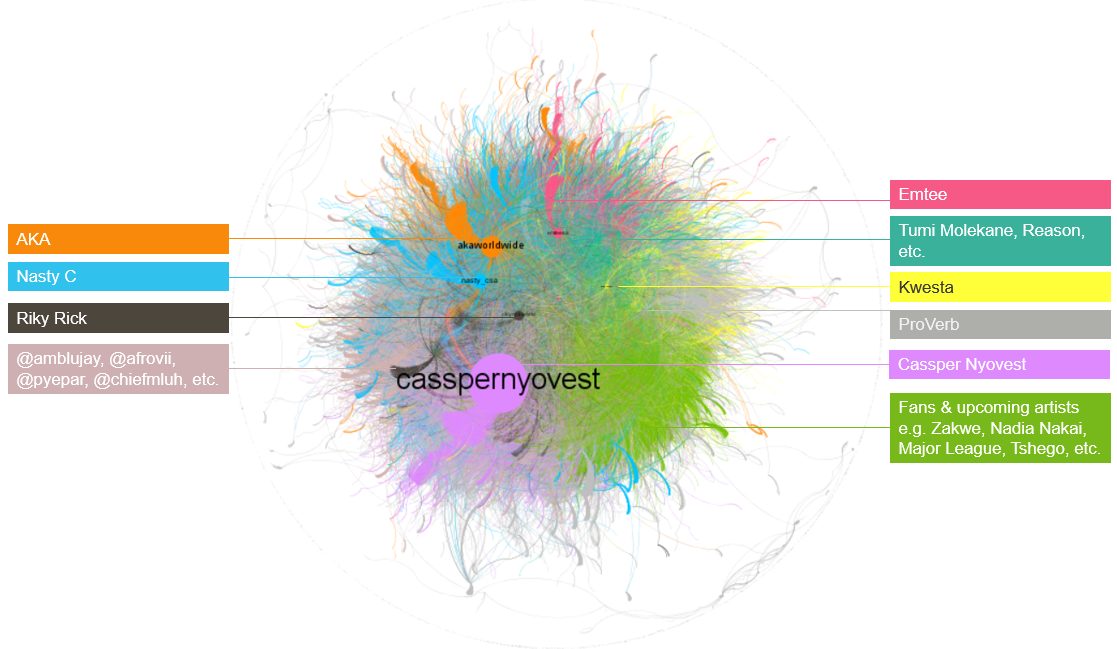
The only thing that South Africans love talking about more than politics is music; especially hip-hop. This blog is concerned with all things South African – politics, history, music and culture; often analysed through the lens of data. One of the biggest parts of our culture is our music, and the place where many South Africans are discussing and experiencing music is in the local hip-hop scene. Sure, we could talk about the Afrikaans music scene, the local electro scene and other similar scenes, but all of these pale into insignificance in terms of size compared to the hip-hop scene. It is for this reason that I wanted to map what the hip-hop landscape looks like on Twitter. Below you will find an analysis of roughly 2,000,000 tweets over about six months.
A big part of hip-hop culture is braggadocio and manufactured feuds. It’s easy to see beyond these feuds though by looking at the data, which shows us whose really most popular and what people are saying about various artists. In addition, we can also find the sub-communities that exist in the scene. For example, as the below charts will show, while the hip-hop scene is dominated by a few key players, there are also many smaller players who each maintain their own sub-communities.
A binary star system
Mainstream South African hip-hop has two figureheads: Cassper Nyovest and AKA. Cassper Nyovest is originally from Mafikeng in the North West while AKA is from Mitchell’s Plain in Cape Town. Over time, these two artists have come to dominate the local scene. Reams of celebrity gossip is written about their rivalry but they each stand on their own as world class artists.
I prefer Nyovest’s music but that is a personal choice. His most recent album, Thuto, gets regular airplay from me. Nyovest’s style is deeply personal. He tells stories about his life that reflect the reality of many South Africans. You can listen to Thuto on YouTube here if you want to get a feel for what he’s about (assuming you are one of the few South Africans who don’t know his music already – I’m looking at you my white friends).
AKA often has more bombastic, international production values but I don’t find he goes as deep in his songs. I also don’t agree with AKA’s politics of race and Radical Economic Transformation (see the virtual company he keeps on Twitter in this previous post about President Zuma’s catastrophic cabinet reshuffle in March/April). The man knows how to put some sick beats together though as evidenced by his music video for The World is Yours:
Cassper Nyovest and AKA are two of the most popular celebrities in South Africa. In terms of Twitter followers, they rival well known politicians such as Julius Malema and Helen Zille, as well as actresses and TV presenters, Bonang Matheba and Minnie Dlamini. Aside from AKA and Cassper Nyovest, there are several other big names in the world of South African hip-hop, including artists such as Nasty C, Riky Rick, Kwesta, Emtee, Khuli Chana, and more. The scene is incredibly diverse and vibrant. It’s this vibrancy that made me want to explore the scene in more detail in the first place as it truly is an important part of South African culture. This chart summarises how many Twitter followers each artist has (along with a few well known celebrities and politicians for context):

Not being familiar with these artists is the equivalent to walking around in the USA and not knowing who Lady Gaga, Kanye West or Beyoncé are; you really are missing an important part of what South Africans are about.
What communities are involved?
Admittedly, I was not that familiar with the local hip-hop scene before starting this research project so I did some Googling in order to decide which artists to include. In the end, I looked for tweets mentioning the following list of artists, producers and promoters (if you think that there’s someone missing from this list, let me know on Twitter or Facebook):
Cassper Nyovest, AKA, Nasty C, Riky Rick, Emtee, Kwesta, Pro Kid, ProVerb, Reason, Tumi Molekane, Khuli Chana, Gigi Lamayne, L-Tido, Morale
I started collecting data on hip-hop artists in June this year. The dataset analysed in this post covers 12 June – 11 December 2017 and includes 2,098,986 tweets (and this was only about half of the tweets generated during this time as I missed quite a few for technical reasons) from 301,275 different Twitter users. South Africans really, really love talking about hip-hop!
This is what the overall network looks like with the main communities involved highlighted in different colours:

The thing that really jumps out at me about the above network is just how ‘messy’ and interconnected it is. It looks like a giant hairball. This means that the people in this community are really engaged with each other; they are interacting with each other at a grass roots level. Sure, there are some clear influencers in the conversation (the various artists), but there’s also a lot of conversation happening between regular users. This is indicative of a passionate community. People really care about hip-hop.
The below chart summarises the top communities based on how many people are in each (x-axis) and the volume of tweets generated by each (y-axis):

The Fans and upcoming artists community clearly stands apart from the other communities. Even though it’s already the second largest community after the community surrounding Cassper Nyovest, it still managed to generate a lot more tweets than we would expect. Almost 35% of all tweets in our dataset came from this community. It’s also an interesting community to unpack in more detail since it contains many upcoming hip-hop artists such as Zakwe, Nadia Nakai and Tshego. The most interesting thing about these artists is that many of them have recorded a track with Cassper Nyovest, showing just how deep his influence runs throughout the industry. It’s not clear to me whether they are all on the same label or whether he is just supporting them in order to grow the scene. Either way, his influence on the industry runs deep.
Whose being spoken about the most?
We saw at the start of the article who has the most followers, but that’s only part of the story. As any digital marketer will tell you, engagement is more important than passive followers. So, who then has the most engagement? To figure that out, we can look at who gets spoken about the most by looking at whose name gets mentioned most often in tweets.
To do that, I counted up how many times each artist was mentioned in our ~2 million tweets. As it turns out, Cassper Nyovest has been mentioned way more than any other artist. He was mentioned by the most people (18% of users in the dataset) and he was mentioned in the most tweets (50% of tweets mentioned him – Nyovest fans are clearly prolific tweeters). He obliterates all other artists when it comes to being spoken about. Based on this data, I’d say that he clearly dominates the South African hip-hop scene, at least on Twitter. Nyovest’s various “fill the stadium” campaigns, where he promotes ever larger stadium gigs, likely drive much of this conversation. Check out this documentary on the recent #FillFNBStadium campaign. You can also watch his #FillUpTheDome concert on ShowMax (trailer).

So, we know that Cassper Nyovest is being spoken about the most, but which parts of the networks are speaking about him? Let’s take a look at a few of what I refer to as “embedded networks” below. These are snapshots of the main network above but where I’ve highlighted the Twitter users that mentioned a specific artist in colour and I’ve left the users that did not mention the artist in grey. This allows us to see which regions of the network are discussing each artist.
As we can see, mentions of Nyovest (in purple below) are spread pretty evenly across the network, although perhaps less so within the communities around the top rim of the network. He also has as strong presence in the Fans & upcoming artists community in the bottom right of the network, which is unsurprising since he’s done so many collaborations with the artists in that community. None of the other artists highlighted below seem to get nearly as many mentions from this community.

Where do their fans live?
Clearly, artists like Cassper Nyovest and AKA have fans all over the country (and the world) but can we see any differences in how their fans are distributed? To investigate this, I looked at the locations that each user types into their Twitter account, and then looked at which words were more likely to appear for users mentioning one artist over another. As it turns out, there do appear to be some distinct regional differences in fan bases.
Nasty C seems to be the most international artist. He’s pulling fans from all over Africa. Users that mentioned Nasty C are also more likely to mention Lagos (Nigeria), Nairobi (Kenya), Accra (Ghana), Uganda, Kampala and England in their location descriptions.
Cassper Nyovest seems to be pulling from around South Africa. Users that mentioned him are also more likely to mention Pretoria/Tshwane, Rustenberg, Sharpville, Soweto, Tembisa and Limpopo in their descriptions. They are also more likely to mention Nyovest’s hometown, Mafikeng and North West province. This is not to say that other artists don’t also pull from these areas, but Nyovest gets higher than expected mentions from these areas.
On the other hand, users that mention AKA are more likely to mention Durban, Johannesburg, Sandton and Botswana in their location descriptions. The Sandton mention is interesting, perhaps pointing towards the ANC elite that he finds himself part of.
Even though users that mention AKA are more likely to mention Johannesburg, the city is really ‘owned’ by Riky Rick whose users are the most likely to mention the city overall.
So, Cassper appears to ‘own’ the far flung and rural parts of the country, while AKA ‘owns’ Sandton and Durban. Riky Rick ‘owns’ Johannesburg and Nasty C has tapped into the rest of the African continent. I’m sure the rest of the artists similarly draw from urban hubs, as well as many other parts of South Africa. Again, just to emphasise, these artists all have fans all over the country, but they have more fans in these areas than we would expect.
What else do hip-hop fans care about?
Finally, I wanted to see what else South African hip-hop fans are interested in. To do this, I used the list of the hip-hop accounts included in the analyses above and took a look at which other Twitter accounts their followers also follow. The results show that we are a nation obsessed with celebrities. Hip-hop fans are also most likely to follow the stars that they see on television and radio. In addition, we follow politicians who have mastered the art of the spectacle, such as Minister of Police, Fikile Mbalula, who never misses a tweet opportunity:


Conclusion
So there you go: now you know what the South African hip-hop scene looks like. While it’s dominated by Cassper Nyovest and AKA, Nyovest clearly dominates overall. Not only does he get talked about the most but he has also cultivated a community of fans and up-and-coming artists that means that his influence and legacy on the scene will persist for a long time to come.
In addition, the scene is made up of many other artists – a truly diverse range. Times are good for the diversity and range of local hip-hop talent which we all get to benefit from. From a cultural perspective, can you really call yourself a worldly, well-informed South African if you aren’t familiar with one of our largest cultural movements? Hopefully this article has gone some way to illuminating the scene, whether you are an existing fan or a newcomer.




